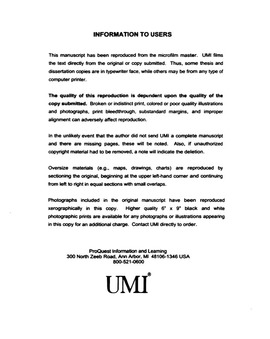| dc.contributor.advisor | Frech, Roger, | en_US |
| dc.contributor.author | York, Shawna Raye Starkey. | en_US |
| dc.date.accessioned | 2013-08-16T12:18:28Z | |
| dc.date.available | 2013-08-16T12:18:28Z | |
| dc.date.issued | 2002 | en_US |
| dc.identifier.uri | https://hdl.handle.net/11244/419 | |
| dc.description.abstract | Linear polyethylenimine (LPEI) is structurally analogous to poly(ethylene oxide), with an N-H group in place of the ether oxygen. LPEI systems with dissolved lithium and sodium triflate were prepared and characterized via Raman and FT-IR vibrational spectroscopy, differential scanning calorimetry, and complex impedance. The understanding of local interactions in the LPEI-salt systems is enhanced by consideration of a small-molecule model of LPEI, N-N '-dimethylethlenediamine (DMEDA). Vibrational spectroscopy of DMEDA-lithium salt systems was used to elucidate ion-ion interactions and the interaction of the solvent with the salt. Mode assignments were made in the DMEDA system. It was shown that the vibrational modes from 700 to 900 cm-1, which are a mixture of CH2 rock and NH bend, are sensitive to interaction with the lithium cation. It was found from the frequency shifts in the NH stretching region that LPEI is more extensively hydrogen bonded than DMEDA and that in both systems hydrogen bonding is decreased when LiTf is added. It was also found that the vibrational modes of the triflate anion are influenced by solvent interactions in the LPEI and DMEDA systems, probably via a hydrogen bonding interaction. | en_US |
| dc.description.abstract | Poly(bis-methoxyethoxyethoxyphosphazene), MEEP, has the same coordinative moiety (CH2CH2O) as is found in the poly(ethyleneoxide) system, but attached to a flexible phosphazene backbone. A spectroscopic comparison of MEEP and three other phosphazenes with ethoxy sidechains of different lengths shows that the dissolved lithium cation coordinates primarily to the ether oxygens in these systems. A comparison of ionic speciation to the concentration-dependant conductivity in the MEEP-lithium triflate system has led to the proposal of a mechanism of ionic conductivity involving associated ionic species via dissociation and rapid reassociation. | en_US |
| dc.description.abstract | Polymer electrolytes are ionic conductors which consist of a salt dissolved in a polymer host. The potential importance of polymer electrolytes in applications such as rechargeable lithium batteries has stimulated intense interest in these systems. Extensive fundamental investigations into the nature of ionic conductivity in these systems have previously been done on poly(ethylene oxide) with dissolved lithium triflate, LiCF3SO3. These investigations are now complemented by considering related polymer-salt systems. This dissertation investigates two such systems. | en_US |
| dc.format.extent | ix, 124 leaves : | en_US |
| dc.subject | Lithium. | en_US |
| dc.subject | Ion-ion collisions. | en_US |
| dc.subject | Chemistry, Physical. | en_US |
| dc.subject | Polyelectrolytes. | en_US |
| dc.title | Local structures and conductivity in polyethylenimine and polyphosphazene polymer electrolytes. | en_US |
| dc.type | Thesis | en_US |
| dc.thesis.degree | Ph.D. | en_US |
| dc.thesis.degreeDiscipline | Department of Chemistry and Biochemistry | en_US |
| dc.note | Major Professor: Roger Frech. | en_US |
| dc.note | Source: Dissertation Abstracts International, Volume: 63-01, Section: B, page: 0286. | en_US |
| ou.identifier | (UMI)AAI3038982 | en_US |
| ou.group | College of Arts and Sciences::Department of Chemistry and Biochemistry | |
